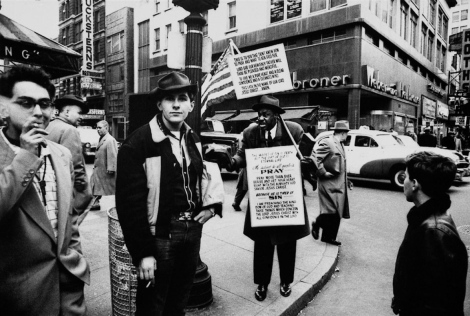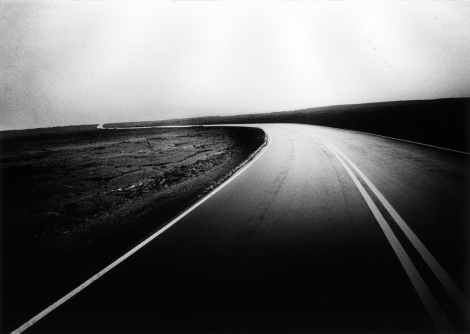
Pray, Sin, New York by William Klein
This current exhibition at Tate Modern presents, in a dual-retrospective, work by American photographer and filmmaker William Klein, and Japanese photographer Daido Moriyama. Although these two artists don’t appear to have a direct connection, their photography shares very similar themes and methods. Throughout their careers, both Klein and Moriyama have explored different cities and created large monochrome series, instead of choosing to focus on individual images. These photobooks, rather than representing a finished piece of art, document a journey through city life in the ever-changing world of the nineteen-sixties.
William Klein’s film Broadway by Light takes up an entire wall in the first room of the exhibition: colourful images of New York lights, flashing neon across the screen like a Broadway billboard. This collage of vivid signs, building facades and bright lights was filmed in 1958 and creates a perfect portrait of the city and everything it represented at the time, as well as drawing a certain affinity with French New Wave. The camera zips through streets at night, against a perfect backdrop of wild jazz frantically accompanying the images. Billboard signs and colourful text run across the screen, but most of the words are incomplete, illegible. There’s an excess of information – none of it decipherable. Although this cleverly controlled chaos only shows us rapidly moving images, moving too fast to take anything in, I get a real sense of nineteen fifties New York. The jittery jazz music, the bursts of colour and flashing lights, the sense of restlessness… I think of the Beat Generation.
After having spent a few years in Paris, at the time when he returned to New York, Klein started putting together a visual diary of the city’s bold character and transformation. Day after day, he hunted the streets, gathering what he called “evidence”. The result is an impressive collection of images that together create a portrait of the city. Curious passers-by stare out at me, excited to have their picture taken. Unknown faces gaze into the camera, sometimes with a look of wonder and fascination, other times with a look of tiredness or despair, stupor or anxiety or joy… and always that sense of movement. I can almost hear the hustle and bustle of the streets, smell the stench of the gutter, hear the laughter of children playing in dirty alleyways, I can almost feel the promise of the American Dream. For Klein, New York is a dynamic world of black and white, in which he adopted a specific way of moving through the streets, using a wide-angle lens and facing his subjects upfront, thrusting himself into the crowds.
In his documentary film, Gran Soirs et Petit Matins, again we sense an explosion of life, of vitality gushing through the city streets, where humanity comes to life. The film was shot in Paris during the 1968 student riots, and like a lot of his work, reads like a manifesto of human experience. “To the streets! To the streets!” the crowd chants, like a motto for William Klein’s work.
Moriyama’s photography represents a colder, more detached approach to street photography, which often adopts a critical or provocative quality. His images capture forgotten fragments of Tokyo’s street life – mainly by night, and through predominantly dark atmospheres, presenting us with a different representation of humanity which seems to have little in common with the dynamism of Klein’s lively passers-by. With voyeuristic characteristics, Moriyama’s work tends towards an investigation of both desire and disgust, in his view of city life he seeks to emphasise both the beauty and the tragedy of it. Couples run across night streets in a blur, cars speed past, upside-down neon signs flicker in the dark. With Moriyama the actions are always ephemeral, we don’t get the sense of identity that we find in Klein’s work. Like fleeting memories, strangers brush by – a matter of seconds and they’ve already been forgotten.
Reminiscents of the Beat generation from Klein’s early work reappear in Moriyama’s Hunter 1972, indirectly inspired by his reading of Kerouac’s On the Road. Blurred, grainy, shaken photographs, this series portrays, in the artist’s own words, “a road map of images from all over Japan through a moving car window”. A strong sense of freedom emerges in Hunter – this particular set of images feels more natural, more real, without needing to be provocative or critical. Farewell Photography, published in that same year, again features a prominent sense of movement, but this time expressed through the photographic process itself, creating an analogy between the act of developing and the thought process. Most of these snapshots are blurred – a distorted vision of the city, like a fleeting memory, like drunken jazz haze.
There’s been some debate regarding Simon Baker’s (Tate Modern’s photography curator) choice in displaying these two artists side by side. People have argued that William Klein’s work, which opens the retrospective, overshadows Daido Moriyama’s half of the show. Although this might be true, the sequence seems to work chronologically. As a dual-retrospective, it works perfectly. There’s plenty to be said about both artists, with similar themes running smoothly between the two, and a certain feeling that sticks with you as you walk through the exhibition, and lingers on when you step outside onto the streets of the city.

From the series Hunter by Daido Moriyama
